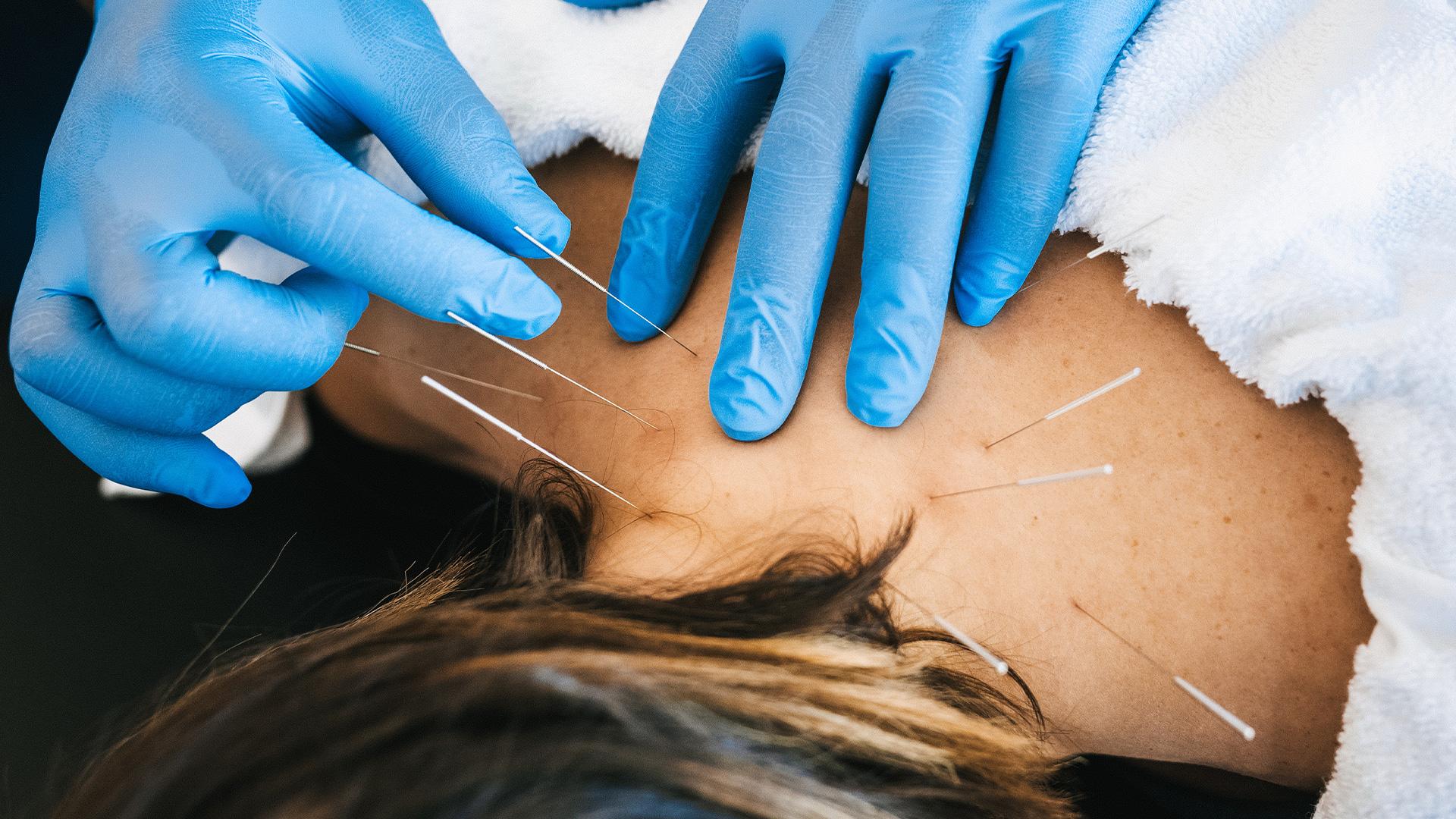Is dry needling right for you?

Dry needling, also known as intramuscular stimulation, is a treatment therapy that uses thin, threadlike needles to penetrate stiff or knotted muscles that are injured or causing pain. The treatment focuses on musculoskeletal “trigger points,” which are tight bands in muscle tissue that may lead to pain. These trigger points may also be the source of a limited range of motion and loss of flexibility. Dry needling is used in addition to an exercise program to relieve muscular pain and stiffness while improving the abilities of those muscles to contract and relax.
To address these trigger points, a physical therapist inserts thin, sterile needles – like those used in acupuncture – into the tight or sore muscle. It’s called “dry needling” because, unlike an injection, no substance is put into the body as a part of the process. Instead, the needle penetrates the muscle tissue, potentially causing a local twitch response that can release tension and reduce pain. Dry needling influences the local tissue where the needle is inserted, an associated spinal cord level, and the brain to reduce pain and improve muscle performance. The needle insertion has been shown to increase blood flow, reduce pain, and promote tissue healing.
Dry Needling vs. Acupuncture
Dry needling may seem like acupuncture; both use thin, stainless-steel needles inserted into the skin to treat pain. However, they are different practices with different uses and benefits. Acupuncture originates from ancient Chinese medicine while dry needling is a Western medicine approach informed by a modern understanding of science and the human body.
Who Performs Dry Needling?
It is best to seek treatment from physical therapists credentialed to perform dry needling treatments. These providers have extensive knowledge of the musculoskeletal and neurological systems, which inform them on safe, effective needle placement to maximize potential benefits. Plus, physical therapists are subject to insurance and other healthcare standards that may not be common practice with other dry needling providers.
Dry Needling and Physical Therapy
Dry needling is most effective when combined with a broader treatment plan including active interventions like resistive exercise and aerobic training. Dry needling may help reduce pain and increase a patient’s range of motion, allowing them to move better, and speed up their recovery process.
Common Dry Needling Techniques
In dry needling therapy, needles are usually left in the skin for short periods. Each provider may determine a different length of time. However, there are some variations to this.
In and Out Technique
Also known as pistoning or sparrow pecking, this form of dry needling relies on the needle being inserted and removed quickly. The needle briefly stimulates the trigger point and is then removed.
Non-trigger Point Technique
Some techniques focus on the peripheral and central nervous systems. With this technique, needles may be inserted into both the area experiencing pain as well as the surrounding areas. Nerves are responsible for transmitting pain and placing the needles along nerve pathways may improve the body’s ability to control pain.
Pros and Cons of Dry Needling
Before beginning any medical treatment, it is important to understand how it works, including any risks or benefits you may experience. This conversation should always include a medical professional, like your physical therapist or doctor. If you are considering dry needling therapy, the good news is there are very few risks and many potential benefits.
Pros
The primary goal of dry needling is to relieve mild to moderate pain, stiffness, or muscle spasms. Many people report increased flexibility and range of motion after the treatment, making it ideal for sports injuries, muscle pain, and chronic pain conditions such as fibromyalgia. Dry needling should not be performed in isolation; it should be performed along with exercise.
Less Invasive
While needles may seem scary, being dry means they are not injecting anything into your body—reducing the risk of allergic reactions or other complications. These tiny needles, exercise, and lifestyle modifications may help you avoid surgical intervention and other invasive treatments.
Fast Recovery
Unlike other invasive treatment options, dry needling does not require a lengthy recovery period. Most people leave a session feeling some immediate relief. Sessions are brief and are often followed by exercise.
Cons
Side effects of dry needling are usually mild, including bruising, bleeding, or temporary soreness at and near the needle insertion site. Serious side effects are rare if sterile needles are used. To avoid potential risks, choose a provider licensed to practice physical therapy in the United States.
Dry Needling Session
Dry needling will be integrated into a session that includes exercise. The needling portion of the treatment session can occur at the beginning, middle, or end depending on your status and the goals of the session. Your physical therapist will review the technique, the location, and how many needles will be used before starting the treatment. Depending on your comfort level and treatment goals, they may start in a small body region and progress to targeting deeper tissues in multiple body regions.
Because dry needles are about the width of a hair follicle and much thinner than needles used to draw blood, they will be less painful when inserted. After the initial poke, you may feel a dull ache or a cramping sensation as the muscle twitches. The intensity of these sensations ranges from mild to something like receiving a deep tissue massage. This will typically settle within 15-30 seconds. You may also feel some ache or soreness over the subsequent days, similar to soreness experienced after a workout. It is recommended that you remain active on the days after a dry needling treatment.
Is Dry needling Right for You?
Dry needling therapy can be built into treatment plans for many conditions, including muscle strains, tendon pain, carpal tunnel syndrome, frozen shoulder, muscle spasms, TMJ dysfunction, and many others.
Dry needling is a safe treatment that provides pain relief to many of our patients.
Find a location